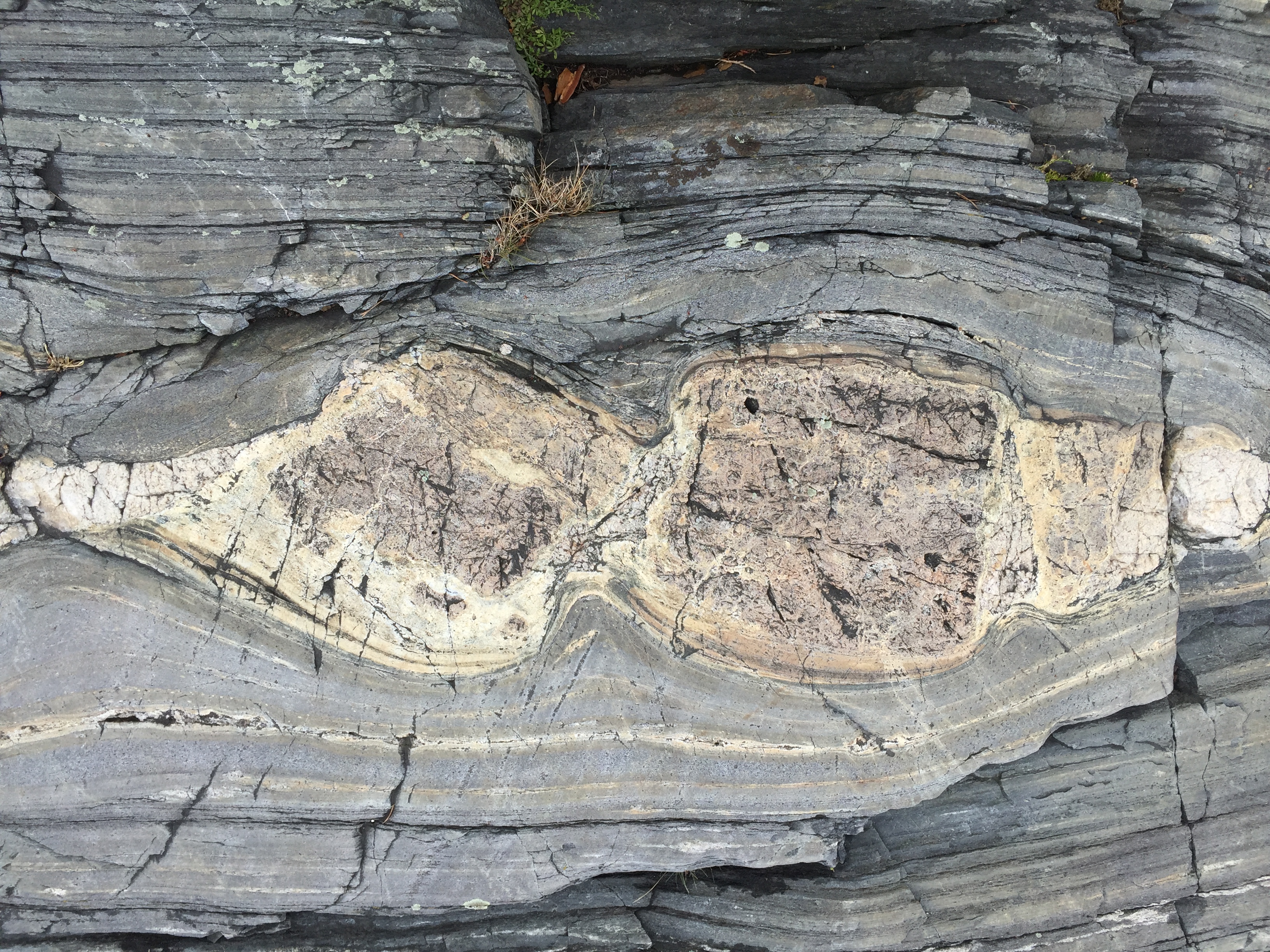boudinage on:
[Wikipedia]
[Google]
[Amazon]

 Boudinaged quartz vein in shear foliation, Starlight Pit, Fortnum Gold Mine, Western Australia.
Boudinaged quartz vein in shear foliation, Starlight Pit, Fortnum Gold Mine, Western Australia.
 Boudinage is a geological term for structures formed by extension, where a rigid tabular body such as
Boudinage is a geological term for structures formed by extension, where a rigid tabular body such as
"Boudinage in Nature and Experiment."
Tectonophysics 526-529, 88-96. In lithospheric-scale tectonics, boudinage of strong layers can signify large-scale creep transfer of rock matter. The study of boudinage can also help provide insight into the forces involved in tectonic deformation of rocks and their strength. Boudinage can develop in two ways: planar fracturing into rectangular fragments or by necking or tapering into elongate depressions and swells.Arslan, Arzu, Cees W. Passchier, and Daniel Koehn (2008)
"Foliation Boudinage."
Journal of Structural Geology, 30 (3), 291-309. Boudins are typical features of sheared veins and shear zones where, due to stretching along the shear foliation and shortening perpendicular to this, rigid bodies break up. This causes the resulting boudin to take a characteristic sausage or barrel shape. They can also form rectangular structures..

 Boudinage is a geological term for structures formed by extension, where a rigid tabular body such as
Boudinage is a geological term for structures formed by extension, where a rigid tabular body such as hornfels
Hornfels is the group name for a set of contact metamorphic rocks that have been baked and hardened by the heat of intrusive igneous masses and have been rendered massive, hard, splintery, and in some cases exceedingly tough and durable. These pro ...
, is stretched and deformed amidst less competent surroundings. The competent bed begins to break up, forming sausage-shaped boudins. Boudinage is common and can occur at any scale, from microscopic to lithospheric, and can be found in all terrane
In geology, a terrane (; in full, a tectonostratigraphic terrane) is a crust (geology), crust fragment formed on a tectonic plate (or broken off from it) and Accretion (geology), accreted or "Suture (geology), sutured" to crust lying on another pla ...
s.Marques, Fernando O., Pedro D. Fonseca, Sarah Lechmann, Jean-Pierre Burg, Ana S. Marques, Alexandre J.M. Andrade, and Carlos Alves (2012)"Boudinage in Nature and Experiment."
Tectonophysics 526-529, 88-96. In lithospheric-scale tectonics, boudinage of strong layers can signify large-scale creep transfer of rock matter. The study of boudinage can also help provide insight into the forces involved in tectonic deformation of rocks and their strength. Boudinage can develop in two ways: planar fracturing into rectangular fragments or by necking or tapering into elongate depressions and swells.Arslan, Arzu, Cees W. Passchier, and Daniel Koehn (2008)
"Foliation Boudinage."
Journal of Structural Geology, 30 (3), 291-309. Boudins are typical features of sheared veins and shear zones where, due to stretching along the shear foliation and shortening perpendicular to this, rigid bodies break up. This causes the resulting boudin to take a characteristic sausage or barrel shape. They can also form rectangular structures.
Ductile
Ductility is a mechanical property commonly described as a material's amenability to drawing (e.g. into wire). In materials science, ductility is defined by the degree to which a material can sustain plastic deformation under tensile stres ...
deformation conditions also encourage boudinage rather than imbricate
Aestivation or estivation is the positional arrangement of the parts of a flower within a flower bud before it has opened. Aestivation is also sometimes referred to as praefoliation or prefoliation, but these terms may also mean vernation: the ar ...
fracturing
Fracture is the separation of an object or material into two or more pieces under the action of stress. The fracture of a solid usually occurs due to the development of certain displacement discontinuity surfaces within the solid. If a displa ...
. Boudins can become separated by fractures or vein material; such zones of separation are known as ''boudin necks''.
In three dimensions, the boudinage may take the form of ribbon-like boudins or chocolate-tablet boudins, depending on the axis and isotropy of extension. They range in size from about 20 m thick to about 1 cm."Boudinage." Encyclopædia Britannica (2010). Encyclopædia Britannica Online. 06 Oct. 2010 Types
There are three different types of boudinage. These include no-slip boudinage, s-slip boudinage, and a-slip boudinage. No-slip boudinage occurs when there is no slip, resulting in a symmetrical structure. S-slip boudinage occurs when the boudin moves in opposition to the shear movement, whereas A-slip occurs when it moves with the direction of the shear. These types can be further classified into 5 different groups with relation to their general shape. These groups are drawn, torn, domino, gash and shearband boudins. In general, drawn and torn shapes form where there is a no-slip boudinage, domino and gash boudins by A-slip, and shearband boudins by S-slip boudinage.Etymology
Lohest (1909) coined the term ''boudinage'', which is derived from the French word "boudin
Boudin () are various kinds of sausage in French, Luxembourgish, Belgian, Swiss, Québécois, Acadian, Aostan, Louisiana Creole, and Cajun cuisine.
Etymology
The Anglo-Norman word meant 'sausage', 'blood sausage' or 'entrails' in general. ...
", meaning blood sausage. Boudins were first observed and described by Belgian geologists in the Collignon quarry near Bastogne
Bastogne (; nl, Bastenaken, ; german: Bastnach/Bastenach; lb, Baaschtnech) is a city and municipality of Wallonia located in the province of Luxembourg in the Ardennes, Belgium.
The municipality consists of the following districts: Bastogn ...
in the Ardennes (Belgium
Belgium, ; french: Belgique ; german: Belgien officially the Kingdom of Belgium, is a country in Northwestern Europe. The country is bordered by the Netherlands to the north, Germany to the east, Luxembourg to the southeast, France to th ...
).
References
Urai, J. L., Spaeth, G., van der Zee, W. & Hilgers, C. (2001). ''Evolution of Mullion (Boudin) structures in the Variscan of the Ardennes and Eifel.'' In: Jessell, M. J. (2001). General Contributions: (2001). Journal of the Virtual Explorer, 3, 1-16 https://web.archive.org/web/20070908134406/http://www.virtualexplorer.com.au/journal/2001/03/urai/ {{Commons category, Boudinage Structural geology Metamorphic rocks